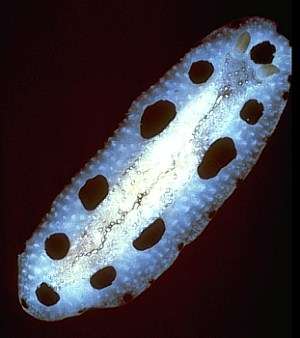
Phyllidiopsis loricata
(Bergh, 1873)
Order: NUDIBRANCHIA
Suborder: DORIDINA
Family: Phyllidiidae
DISTRIBUTION
Known from the Great Barrier Reef, Timor Sea (northern Australia), Guam, the Marshall Islands, Enewetok Atoll and the type locality, Tahiti.
PHOTO
Collected intertidally, Mandora Point, Darwin, NT, November 1972, dorsal view of 40 mm specimen, Photo: N. Coleman (Brunckhorst, 1993: Plate 8C).
Notes compiled from Brunckhorst, 1993:
Phyllidiopsis loricata is distinguished by the following: its white dorsum with black to dark brown spots; rough mantle surface; pointed white rhinophores with 16-19 lamellae on each clavus (specimens greater than 15 mm); white ventral coloration; and large, square shaped oral tentacles.
Phyllidiopsis phiphiensis, Phyllidiopsis annae and Phyllidiopsis striata possess white and black coloration but differ considerably in being striped. Phyllidiopsis loricata is superficially similar to Phyllidia scottjohnsoni
which has large black spots, medially, on a pale cream-white background. It is difficult to separate these two species on external characters alone. The main external features which differentiate the two species are the lack of spots mid-dorsally and the large, fused, square oral tentacles of the present species. Phyllidiopsis loricata has a greater number of lamellae on the rhinophoral clavus than Phyllidia scottjohnsoni.
Reference:
• Brunckhorst, D.J. (1993) The systematics and phylogeny of Phyllidiid Nudibranchs (Doridoidea). Records of the Australian Museum, Supplement 16: 1-107.
Rudman, W.B., 1999 (August 1) Phyllidiopsis loricata (Bergh, 1873). [In] Sea Slug Forum. Australian Museum, Sydney. Available from http://www.seaslugforum.net/find/phyllori
Related messages
Re: Phyllidiopsis loricata from southern Queensland
June 9, 2007
From: Gary Cobb
Concerning message #19095:
Bill,
The photo was taken in situ just as I found it. The dive was a bit a surgey and my guess is that it was knocked off its perch!
Thanks
Gary Cobb
gary@nudibranch.comau
Cobb, G.C., 2007 (Jun 9) Re: Phyllidiopsis loricata from southern Queensland. [Message in] Sea Slug Forum. Australian Museum, Sydney. Available from http://www.seaslugforum.net/find/19994Thanks Gary,
I didn't think that you had 'posed' the animal. It was just the way the mantle was wrinkled and not flat that made me feel the animal was 'uncomfortable'. Knocked off its perch by the surge is probably a more likely suggestion than a curious fish.
Best wishes,
Bill Rudman
Phyllidiopsis loricata from southern Queensland
June 8, 2007
From: Gary Cobb
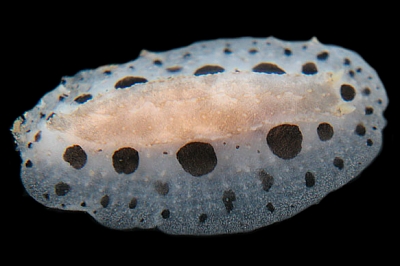
Hi Bill,
While searching for opisthobranchs here on the Sunshine Coast at Old Woman Island I came across Phyllidiopsis loricata resting on a piece of coral. I noticed that this species is not seen very much and that this could be a new record for southern Queensland.
Locality: Old Woman Island , 10m, Queendland, Pacific Ocean, 29 December 2006, Subtidal. Length: 18mm. Photographer: Gary Cobb.
Gary
gary@nudibranch.com.au
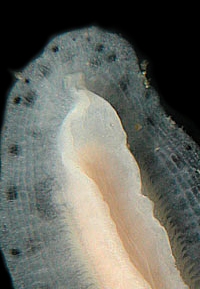
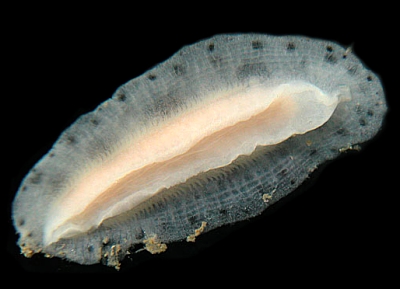

Dear Gary,
Thanks for this record of a rarely reported species. It would be interesting to know how it got to be where it is in your photo as it doesn't look to happy to me amongst the cnidarians. Perhaps it had been 'tasted' by a fish and dropped. Your shot of the underside is valuable when dealing with phyllidiids because it is often the place where we can find identification clues. For example the strange structure in front of the mouth is a flap formed from the fusion of the oral tentacles, and fused oral tentacles like this are found only in Phyllidiopsis. We can also see the bank of small lamellae on each side where the mantle meets the side of the body. These are the secondary gills which in phyllidiids have replaced the circle of dorsal gills normally present in dorid nudibranchs.
Best wishes,
Bill Rudman
Phyllidiopsis loricata from Reunion Island
November 1, 2005
From: Philibert Bidgrain
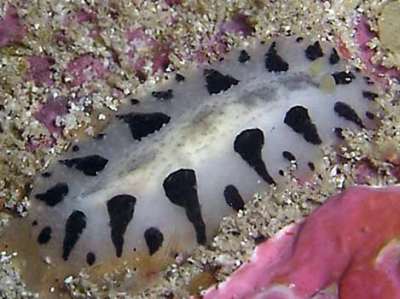
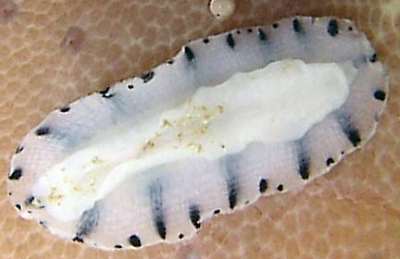
Dear Bill,
Reunion Island sea slugs.
This is the first time we have seen this species at Réunion Island, Indian Ocean. It was observed by Florence Trentin, "Maison verte" at Saint Leu, 18 m, 18 September 2005, Length: 15-18 mm Photographer: Florence Trentin
It seems to be a specimen of Phyllidiopsis loricata. But this species is described from the Great Barrier Reef, Timor Sea (northern Australia), Guam, the Marshall Islands, Enewetak Atoll and the type locality, Tahiti.
What's your opinion about this id ? May be a larger distribution in Iindian Ocean?
Best Regards
Philibert Bidgrain
http://vieoceane.free.fr/runseaslug/indexslug.htm
pbidgrain@yahoo.fr
Bidgrain, P., 2005 (Nov 1) Phyllidiopsis loricata from Reunion Island. [Message in] Sea Slug Forum. Australian Museum, Sydney. Available from http://www.seaslugforum.net/find/15132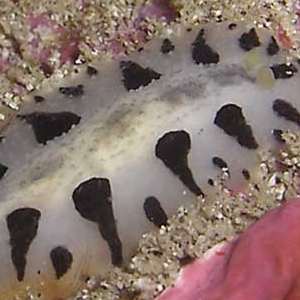
Dear Philibert,
It certainly seems to be Phyllidiopsis loricata. The colour pattern, the tuberculate and raised median strip, and the fused and quadrangular oral lobes, which can be seen well in the ventral photo all suggest it is this species. It seems that we can add the Indian Ocean to its geographic distribution.
It certainly makes me wonder whether the animal we have from Hawaii [message #11026] is correctly identified. I previously mentioned its broad rounded shape as being rather different, and now your photo showing the flattened tuberculate central band very clearly, suggests that the Hawaiian animal may be a different species
Best wishes,
Bill Rudman
Phyllidiopsis loricata from Hawaii
September 24, 2003
From: Keoki Stender
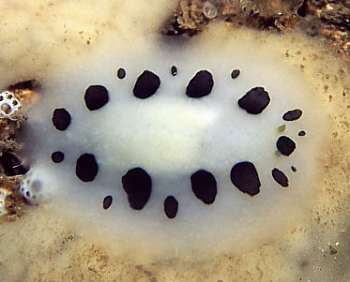
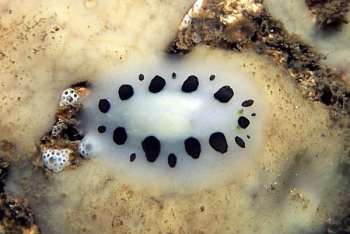
Hi Bill,
I've found two similar-looking phyllidiids in Hawaii.
Last week [September 2003] I found what looks like Phyllidiopsis loricata in a cave at Pupukea on the north shore of Oahu. The depth was 7m. According to your notes it is not reported from Hawaii.
In a separate message I have reported on the very similar-looking Phyllidia scottjohnsoni which was taken at Midway Atoll in a cave at 15m. They are quite common there but I've never seen one here in the main islands.
Thanks,
Keoki Stender
fishpicshi@yahoo.com
Stender, K., 2003 (Sep 24) Phyllidiopsis loricata from Hawaii. [Message in] Sea Slug Forum. Australian Museum, Sydney. Available from http://www.seaslugforum.net/find/11026Dear Keoki,
This is an interesting find. Apart from the photo in Brunckhorst (1993) which is reproduced on the Fact Sheet, I don't know of any other photo of this species. The animal in that photo seems much more narrow than your animal but I suspect it is because it is apparently photographed on glass, and often animals on glass don't 'feel comfortable' and so the foot is not fully attached. I would suspect the cream sponge you have photographed this animal on is its food sponge. If you get a chance it would be useful to see if it is regularly found on this sponge, and if so, whether you can see any sign of feeding.
Concerning its distribution. As far as I know it has not been reported from Hawaii before so your record is a valuable addition to our knowledge. It has quite a wide distribution in the western Pacific so its presence in Hawaii is not surprising.
Best wishes
Bill Rudman
